Influences of air CO2on hydrochemistry of drip water and implications for paleoclimate study in a stream-developed cave,SW China
2016-10-20XiaoxiaoWangYanhongWuLichengShen
Xiaoxiao Wang·Yanhong Wu·Licheng Shen
Influences of air CO2on hydrochemistry of drip water and implications for paleoclimate study in a stream-developed cave,SW China
Xiaoxiao Wang1,2,3·Yanhong Wu1·Licheng Shen3
Cave air CO2is a vital part of the cave environment.Most studies about cave air CO2variations are performed in caves with no streams;there are few studies to date regarding the relationship of cave air CO2variations and drip water hydrochemistry in underground stream-developed caves.To study the relationship of underground stream,drip water,and cave air CO2,monthly and daily monitoring of air CO2and of underground stream and drip water was performed in Xueyu Cave from 2012 to 2013. The results revealed that there was marked seasonal variation of air CO2and stream hydrochemistry in the cave.Daily variations of cave air CO2,and of stream and drip water hydrochemistry,were notable during continuous monitoring. A dilution effect was observed by analyzing hydrochemical variations in underground stream and drip water after rainfall.High cave air CO2along with low pH and low δ13CDICin stream and drip water indicated that air CO2was one of the dominant factors controlling stream and drip water hydrochemistry on a daily scale.On a seasonal scale,stream flows may promote increased cave air CO2in summer;in turn,the higher cave air CO2could inhibit degassing of drip water and make calcite δ13C more negative.Variation of calcite δ13C(precipitated from drip water)was in reverse of monthly temperature,soil CO2,and cave air CO2.Therefore,calcite δ13C in Xueyu Cave could be used to determine monthly changes outside the cave.However,considering the different precipitation rate of sediment in different seasons,it was difficult to use stalagmites to reconstruct environmental change on a seasonal scale.
Carbon dioxide·Underground stream·Drip water·Paleoclimate reconstruction·Xueyu Cave
1 Introduction
The relationship between cave environment and the paleoclimate as recorded in speleothems is a major issue in speleology studies(Wei and Liu 2014).Indeed,cave environment is sensitive to changes in the external environment(Oster et al.2012),and it can also reflect changes of global climate(Zhang et al.2005).Such signs of climate change can be recorded in speleothems that are widely present in caves(Fairchild et al.2006;Lambert and Aharon 2011),especially in the caves of the subtropical area in Southwest China,most of which are affected by the Southeast and Southwest Asia Monsoons from the Pacific and Indian Oceans,respectively(Yuan et al.2004;Li et al. 2011;Zhang et al.2014).Many factors can influence calcite precipitation processes in caves(Spo¨tl et al.2005;Sherwin and Baldini 2011)and cave air CO2levels.One such factor controls the partial pressures of CO2(PCO2)and calcite saturation(SIc)in waters(Sherwin and Baldini 2011).Therefore,the study of cave CO2is an important approach to revealing speleothem growth and variations in paleoclimate proxydata extracted from speleothems.
To date,paleoclimate has mainly been reconstructed in dry caves because fewer parameters are altered comparedto caves with underground streams.Therefore,with a goal of understanding the mechanism by which climate change is recorded by δ13C in speleothems,most studies on cave air CO2have been conducted in caves with no underground streams(Li et al.2011).Nonetheless,many caves have underground streams,which are sensitive to changes in the external environment,especially with regard to rainfall. Previous studies have revealed that the level of karst groundwater rises within several hours after rainfall(Zhang et al.2005;Liu et al.2007).Cave air temperature decreases and cave air CO2varies sharply after rainfall,and a response in underground stream hydro-geochemistry is also evident(Pu et al.2014).Troester and White(1984)studied underground stream PCO2and cave CO2in Tytoona Cave,Pennsylvania,and reported that cave air CO2was affected by degassing of an underground steam;CO2in the stream water was thought to be carried by infiltration water. Studies have also revealed the influences of CO2on carbon isotopic composition of drip water and calcite and on ionic composition of drip water(Hansen et al.2013).Therefore,air CO2in a cave with a flowing underground stream may vary rapidly on a short time scale,and it is important to study variations in air CO2and in hydrochemistry of underground stream and drip water in these caves.
✉ Licheng Shen xqimei@swu.edu.cn Xiaoxiao Wang wxx1989@escience.cn
1Institute of Mountain Hazards and Environment,Chinese Academy of Sciences,Chengdu 610041,China
2University of Chinese Academy of Sciences,Beijing 100049,China
3School of Geographical Sciences,Southwest University,Chongqing 400715,China
Our study was carried out in Xueyu Cave,which is located in Chongqing,SW China.A two-year study on cave air CO2and soil CO2was performed,and cave air CO2and underground stream and drip water hydrochemistry were monitored daily in November 2013 to determine the interaction between cave air CO2and underground stream and drip water.Implications for paleoclimatic study were also considered.
2 Study sites
Xueyu Cave(29°47'00''N,107°47'14''E)is located in the basin of the Long River,a tributary of the Yangtze River,and is 17 km from the downtown of Fengdu County,Chongqing(Fig.1a).The elevation of the cave entrance is approximately 233 m,and the outlet is approximately 55 m above the water level of the Long River.Xueyu Cave developed in the Fangdoushan anticline of the paralleled ridge-valley area of eastern Sichuan.The lithology is limestone of the Lower Triassic.The attitude of the bedrock layer is 320°∠43°,and the geologic structure line direction is NE.Xueyu Cave follows the strike of the bedrock layer,with a surveyed length of 1640 m;most parts of the cave are narrow,with deep passages(Pu et al. 2014).The cave can be divided into three layers(Pu et al. 2015),the underground stream flows through the middle and bottom layers,with several small waterfalls along the stream(Fig.1b),and ultimately flows into the Long River. The temperature of the cave is approximately 16-18°C,and the average temperature is 17.5°C.Humidity in most parts of the cave is above 90%year-round.With a subtropical climate,the local annual precipitation is 1072 mm,and the mean temperature is 17.5°C.Affected by the Southwest and Southeast Asia Monsoons,most rainfall occurs in the rainy months,from April to October.The vegetation over the cave is evergreen broadleaf forest,coniferous forest,and bushwood,and the depth of the soil is approximately 1 m.
3 Field sampling and laboratory methods
On the 15th of every month(some data are absent),the cave air CO2concentration was monitored in the cave from January 2012 to November 2013 at sites S1-S4,distributed among the three layers,using a Testo 535 CO2detector(Testo Instruments Corp.,Germany,0-10,000 μatm,≤±3%).The measurements were carried out in the morning when there were no tourists in the cave. Hydrochemistry of the underground stream was monitored concurrently.
Soil CO2was also assessed in the morning of the 15th of every month using a GT901 infrared air pump CO2monitor(0-50,000 μatm,≤±1%.The soil CO2was sampled using tubes,and this device can pump out CO2when the sampling is performed)at depths of 30,60,and 90 in Zhengjia and 20,30,and 60 in Huoshiya(Fig.1c).The vegetation types are bushwood and evergreen broadleaf forest,and the soil types are brunisolic and yellow soil in Zhengjia and Huoshiya,respectively.Calcite samples at the drip water site,Sdw,were collected on the 16th of every month using glass dishes(the dishes were placed just below the drip site for a month)for δ13C testing(some data are absent,i.e.,when there was no drip water).
Daily monitoring of cave CO2(S1-S4)and of underground stream water(S1,S3)and drip water(Sdw)was performed in November 2013.Water samples for cation analysis were collected using polyethylene bottles(50 ml)and thenacidifiedwith1:1nitricacid;anionanalysissamples were collected with 500-ml high-density polyethylene bottles.Water samples for δ13CDICmeasurement were collected in clean 10-ml high-density polyethylene bottles using 0.45 μm cellulose acetate membrane filters;the samples were spiked with 0.1 ml saturated HgCl2to prevent microbial activity(Taipale and Sonninen 2009).All water samples werestoredrefrigeratedat4°Cpriortoanalysis.Thespecific conductivity,pH,and water temperature were measured using a hand-held water quality meter measurement(Merck Corp.,Germany;accuracy was 1 μS/cm,0.01 pH,0.1°C). The HCO-3and Ca2+concentrations of the water were measured in the field by titration with a Merck alkalinity andhardness portable testing kit(Merck Corp.Germany;accuracy was 0.1 mmol/l and 2 mg/l,respectively).A BS28-VP2 miniweatherstation(DavisCorp.,USA)wasplaced approximately500 mawayfromtheentranceofXueyuCave to obtain rainfall and atmospheric temperature data(the accuracy was 0.01 mm and 0.1°C,respectively).The discharge of the underground stream was monitored at 15-min intervals using a CTDP 300(Greenspan Corp.,Australia)multi-channel data logger during the daily monitoring in November 2013.At the same time,soil CO2was continuously monitored every 15 min in Zhengjia at a depth of 30 cm using a GT901 infrared air pump CO2monitor(the parameters of the monitor are presented above).
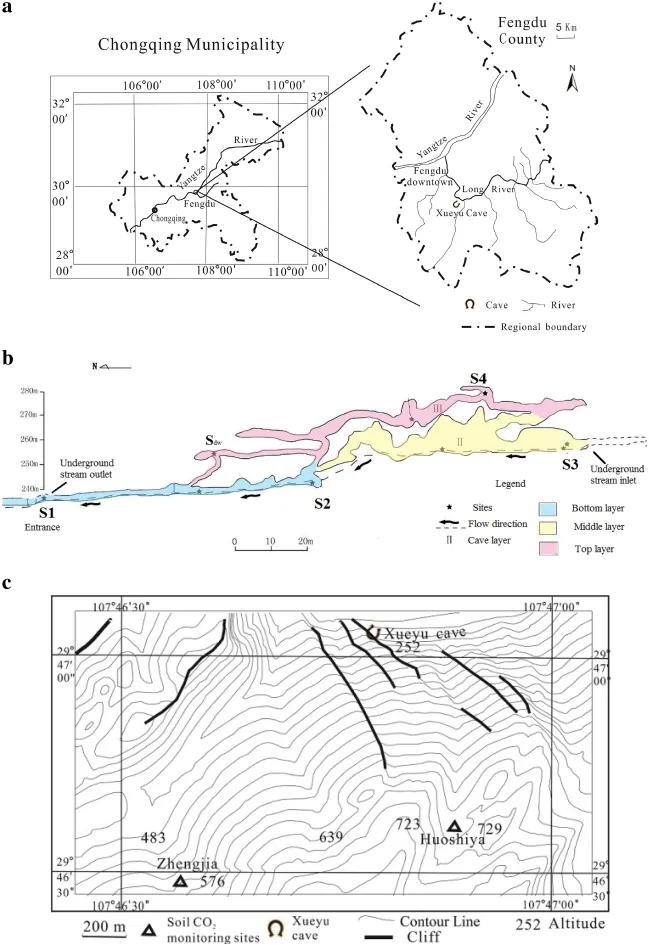
Fig.1 a Location ofXueyu Cave,Fengdu County,Chongqing Municipality.b Section map ofXueyu Cave and monitoring sites in different layers(Wang 2010).c Location of soil CO2sampling sites
Cations in the water samples were assessed at the Geochemistry and Isotopic Laboratory of Southwest University using an Optima 2100DV ICP-OES(Perkin-ElmerCorp. USA),with an accuracy of 0.001 mg/l;analytical errors were within±5%compared with the standard error.Anions were analyzed using ion chromatography within 1%error(compared with standard error)at the Water Environmental Laboratory of the School of Geographical Sciences,Southwest University.δ13C of the sediments was measured using a Delta VPlus gas isotope mass spectrometer combined with a KielIV automated carbonate device at the Geochemistry and Isotope Laboratory of the School of Geographical Sciences,Southwest University.The international standard NBS19 and laboratory standards NCKU1 and SWU1 were measured after every five and seven samples,with a longterm 1r precision of 0.06‰.Water δ13CDICwas analyzed on a Delta plus XL with a 1r external precision of 0.15‰at the Testing and Analysis Center,Institute of Environment and Sustainable Development in Agriculture,Chinese Academy of Agricultural Science.Water temperature,pH,Ca2+,Mg2+,HCO-3,K+,Na+,Cl-,and SO42-were used to calculate PCO2and SIc with the program WATSPEC(Wigley 1977).IBM SPSS Statistics 22 and OriginPro 2015 were used for the statistical analysis.
4 Results
4.1 Atmospheric temperature and rainfall in the area of Xueyu Cave
Cave air temperature in closed caves is always the same as the local annual mean temperature(Sebela and Turk 2011;Casteel and Banner 2015;Lobo et al.2015).According to our study in Xueyu Cave,cave air temperature was stable,ranging from 16.0 to 18.0°C,with an average temperature of 17.5°C.Consistent with the subtropical monsoon climate in the area,the lowest atmospheric temperature during our study period was in January(1.1°C)and the highest in August(39.9°C).In 2012,the average temperature outside the cave rose higher than the average temperature inside the cave in April and sank lower in November(Fig.2).In 2013,the external temperature became higher than the inner cave mean temperature at an earlier date.Rainfall showed two peaks in 2012,appearing in May and September,but there was only one rainfall peak in 2013(Fig.2).More precipitation occurred in late spring and early summer,with less rainfall in July and August due to the subtropical anticyclone.
4.2 Seasonal variations of soil CO2,cave air CO2,and underground stream hydrochemistry
Soil CO2varied seasonally in our study(Fig.3),it was high in summer and low in winter.The highest concentration was approximately 40,000 μatm,and the lowest was approximately the same as the atmospheric CO2concentration.The variations in soil CO2paralleled those in atmospheric temperature.Differences in soil CO2concentration between the two sites were observed,with the concentration much higher(1000 μatm)at Huoshiya than at Zhengjia.
Corresponding to seasonal fluctuations of atmospheric temperature and soil CO2,cave air CO2varied seasonally(Fig.4a).Cave air CO2was high in summer and low in winter.The highest CO2concentration in the cave was more than 10,000 μatm,and the lowest was approximately 400 μatm.The air CO2increased in April and decreased in November,with a trend similar to that of atmospheric temperature.The CO2concentration was lowest at the downstream site(S1),which might be due to ventilation near the cave entrance(Linan et al.2008;Sanchez-Canete et al.2013).
Consistent with the variations of soil CO2and cave air CO2,hydrochemistry of the underground stream in Xueyu Cave showed seasonal variations(Fig.4b-h).Values of pH were low in summer and high in winter,with a range of 6.73-8.60.Spc,Ca2+,and HCO-3showed almost an inverse trend(high in summer and low in winter)compared with the variation of pH.Influenced by high temperature and less rainfall in August 2012,concentrations of Ca2+and HCO-3and Spc dropped noticeably.Contrary to the variations in 2012,Spc,Ca2+,and HCO-3increased consistently through 2013.Water temperature(Tw)was stable during our two-year study;the average water temperature of the stream was 16.4°C.Partial pressure of CO2(PCO2)in the stream was consistent with the variations of Spc,Ca2+,and HCO-3in 2012,whereas PCO2showed an inverse trend in 2013.Saturation index of calcite(SIc)varied differently compared with the variation of PCO2-it was low in summer and high in winter. Overall,seasonal variations of stream hydrochemistry,soil CO2,and cave air CO2were notable during our study period.
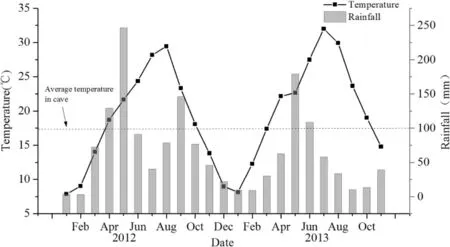
Fig.2 Atmosphere temperature and rainfall in the area of Xueyu Cave
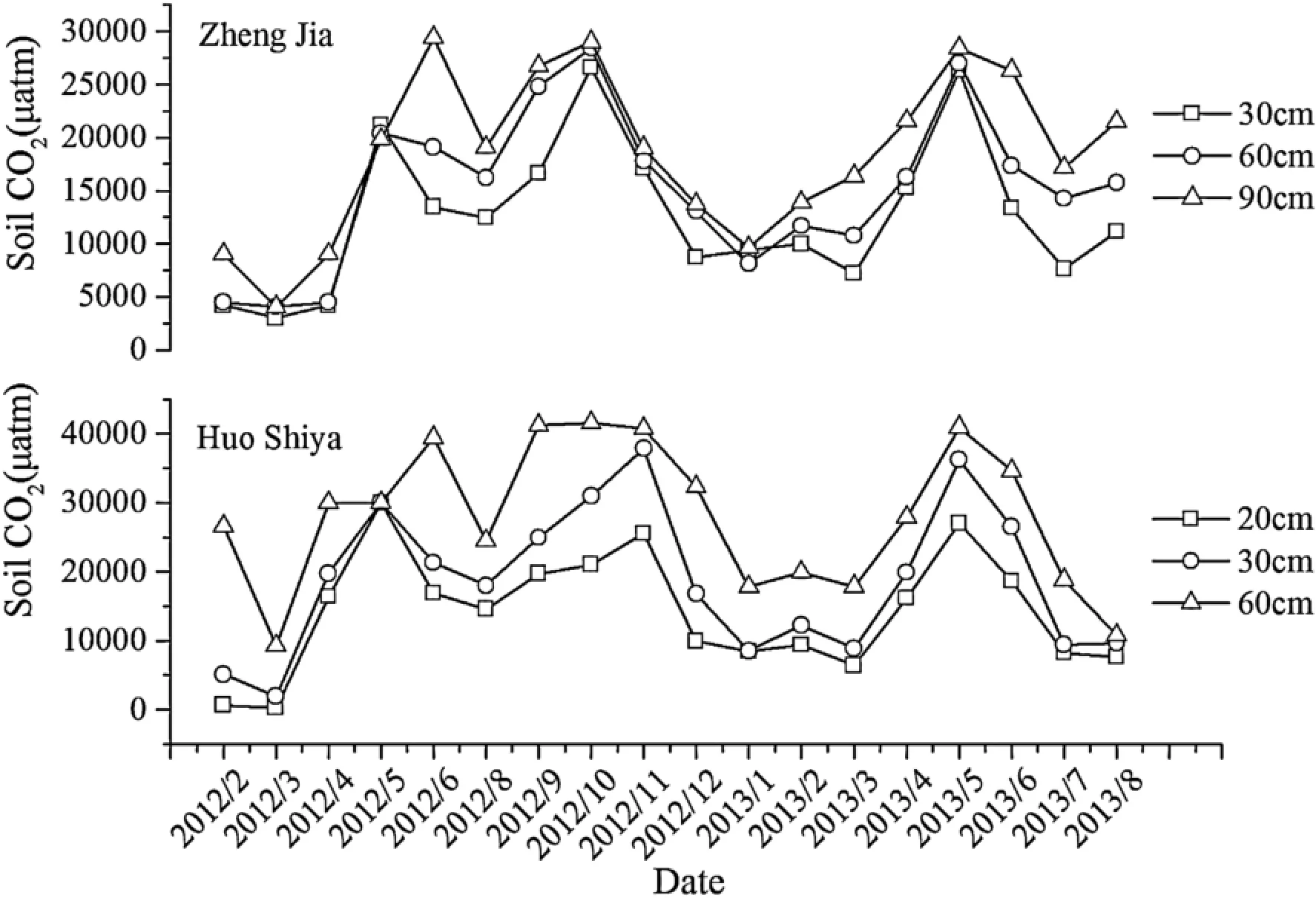
Fig.3 Seasonal variations of soil CO2in Zhengjia and HuoShiya

Fig.4 Seasonal variations of air CO2and underground stream hydrochemistry in Xueyu Cave
4.3 Daily variations of cave air CO2and of underground stream and drip water hydrochemistry
Existing in a relatively closed space,cave air CO2can be temporarily stored within the cave,and thus affect carbon exchange at the water-air interface.In our study,cave air CO2rose to more than 10,000 μatm from 30th October to 9th November 2013,with a slight decrease on 6th November(Fig.5a).The value then fell quickly and air CO2became lower than the original CO2concentration(4740 μatm on average)on November 17th.We found air CO2concentrations downstream(S1)were affected by gas exchange between the interior and exterior,as this site was close to the cave entrance.Thus,it was reasonable that CO2variations between S1 and the other sites were larger during the decreasing period(Fig.5a).Midstream site S2 was located near a waterfall,with water flowing from the middle layer to the bottom layer of the cave.The air CO2concentration was higher at S2 than at the other three sites on November 17th,a time when the air CO2declined at all the monitoring sites in the cave.Not far from upstream site S3 was the inlet of the underground stream,and the cave air CO2at S3 was almost the same as that of S2 during our continuous study.However,the air CO2concentration at the midstream site(S2)was lower than at the upstream site(S3)on November 17th,which might be due to the dynamic degassing of stream water at S2,whereas the stream water flowed calmly at S3.S4 was located at the top layer,the variation of air CO2was slow and gradual.The air CO2at S4 reached a peak 1 day later in comparison with the other three monitoring sites;air CO2at S4 declined simultaneously with S2 and S3 after peaking.
为了规避全球金融账户涉税信息自动交换过程中引发的纳税人信息维护的法律风险,全球金融账户涉税信息自动交换行动参与国应依托《协定公约》相关规范指引,借鉴欧盟和美国的经验,积极制定实施本国相关的纳税人权利保护法律制度,或者完善现行的纳税人权利保护制度,引入纳税人信息保护权利,高度关切保护纳税人信息的隐私权和知情权。
The hydrochemistry of the underground stream was monitored simultaneously with air monitoring.Synchronization of HCO-3,Spc,and Ca2+of the groundwater stream increased from Nov 3rd to Nov 10th and then decreased(Fig.5).The low pH,low SIc,low δ13CDIC,and high PCO2of stream water occurred at almost the same time on Nov 9th.When water flowed into the cave,spatial variations of water temperature were found:it was higher at S1(downstream site)and lower at S3(upstream site).The pH decreased from 8.20 to 7.30 before Nov 9th,with little fluctuation,andincreased again to 8.30.Rain water pH during the study was 7.96 and it was lower than pH of the stream water. The curve of PCO2showed a same shape as that for air CO2,reaching a peak value when the cave air CO2was highest on Nov 9th.
Drip water hydrochemistry was stable before the second rainfall on Nov 12th.After Nov 12th,Tw,pH,Ca2+,andincreased and Spc and δ13CDICdecreased(Fig.6). The average Tw,pH,Spc,Ca2+,andof drip water were 17.4°C,7.98,733.81 μS/cm,185.56 mg/l,and 449.87 mg/l,respectively,during our study.
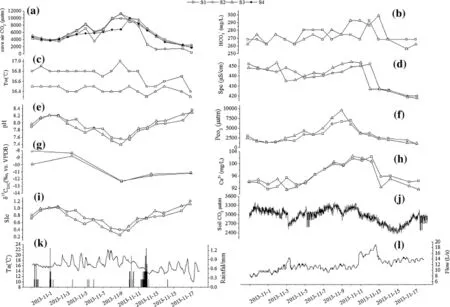
Fig.5 Daily variations of air CO2(a),underground stream hydrochemistry(b,c,d,e,f,g,h,i)in Xueyu Cave,soil CO2at 30 cm depth at Zhengjia(j),atmosphere temperature and rainfall(k),and stream flow(l)
5 Discussion
5.1 Rainfall and hydrochemistry of underground stream and drip water
In previous works,underground stream and drip water were found to be sensitive to rainfall events;hydrochemistry variations on yearly,seasonal,and daily scales have been reported,especially variations in underground stream and drip water hydrochemistry during a storm event(Zhang et al.2005;Liu et al.2007).Considering the dualistic structure of karst systems,underground stream and drip water hydrochemistry responds quickly to rainfall events:a massive influx of rainwater into the epikarst zone after soil infiltration flushes out‘‘old water’’in cracks,a process known as‘‘piston flow’’(Pu et al.2014).The‘‘fresh water’’will then flow into the stream,affecting hydrochemistry of underground stream and drip water. Subsequent rainfall will then cause a dilution effect with respect to hydrochemistry.
Seasonal hydrochemistry variation of the underground stream was mainly controlled by atmospheric temperature and rainfall,with pH and SIc low in summer and high in winter.In contrast,Spc,HCO-3,and PCO2were high in summer and low in winter.Rainfall might have been a major factor influencing the variation of stream hydrochemistry when considering monthly variation of stream hydrochemistry in 2012,which varied in coordination with rainfall.However,variation of rainfall could not explain the variation of stream hydrochemistry in 2013.Due to the rapid changing of stream hydrochemistry,daily monitoringwas need to study rainfall’s effects on hydrochemical variations.

Fig.6 Daily variations of drip water hydrochemistry
DuringourdailystudyfromOct30thtoNov17th(Fig.5),two rainfall events occurred,with precipitation of 4 and 22 mm.The discharge of underground streams showed an obvious response to rainfall(Fig.5l),and response time was approximately 4 h,as we previously reported(Wang et al. 2013).Pistonflowanddilutioneffectwereobservedafter the two rainfall events.The higher pH,SIc,and Spc,and lower PCO2values before Nov 3rd reflect the‘‘old water,’’which was pushed out by the first rainfall.There was sufficient retentiontimeintheepikarstzonefor‘‘oldwater’’toreactwith bedrock,and the dissolved CO2in water was consumed,resulting in an increase in pH and SIc,and a reduction in PCO2.With decreased erosive ability,the stream hydrochemistry varied indistinctively between upstream and downstream sites under the influence of‘‘old water.’’The discharge of the underground stream reached its first peak on Nov3rd,withlowerSpc,Ca2+,andvalues,showinga responsetimeforstreamdischarge afterasmallrainfallevent of approximately 2 days.The rain water had enough time to dissolve CO2when it infiltrated through the soil,and the solution of soil CO2in rain water could be observed by the reduction in overlaid soil PCO2(Fig.5j).The second rainfall duringourstudywasonNov10thand11th,anddilutioneffect oftherainfallwasevidentwithdecreasesin,Ca2+,and Spc on Nov 13th.The response time of stream discharge was lessthanoneday,revealingthattheresponsetimewasrelated to the amount of rainfall.Though soil CO2dropped after the second rainfall,which might mean soil CO2had dissolved in rainwater,PCO2decreasedfortheremainderofthetimeseries after Nov 9th.pH,SIc,and δ13CDICshowed no decreasing trend.The peaks of pH,PCO2,and air CO2occurred concurrently,but at a time that was not consistent with a rainfall event,indicating hydrochemistry of the stream was not influenced only by rainfall,but also by cave air CO2.
Hydrochemistry of drip water was almost unaffected by the first rainfall,showing no evident variation after Nov 3rd(Fig.6).This might be due to less rain water infiltrating through the bedrock.Dilution effect of the second rainfall is shown in Fig.6:water temperature,pH,Ca2+,andconcentrations increased,and Spc decreased after the second rainfall.
5.2 Carbon exchange at water-air interface on daily and seasonal scales
The exchange of carbon between an underground stream and cave air can be reflected in hydrochemistry variations(Troester and White 1984).The high cave air CO2with low pH,low SIc,low δ13CDIC,high Ca2+,and high PCO2of stream water occurred at almost the same time on Nov 9th with no preceding rainfall event(Fig.5),indicating the variations of stream hydrochemistry were affected by caveair CO2,especially carbon exchange at the water-air interface.Equilibrium PCO2in stream water was calculated to determine carbon exchange at the water-air interface(Fig.7a,b).Outgassing of stream water would be expected if PCO2were higher than equilibrium PCO2and air CO2should dissolve into water when equilibrium CO2is higher than stream PCO2.Cave air CO2and equilibrium CO2were always higher than stream PCO2at the upstream site(S3),suggesting more cave air CO2was dissolved in stream water and cave air CO2controlled pH,SIc,PCO2,and δ13CDICvariations.The relationship between stream PCO2and equilibrium CO2at the downstream site(S1)was almost the same as the upstream site(S3)before Nov 12th,but Stream PCO2was higher than equilibrium CO2at the downstream site(S1)after Nov 12th,indicating that outgassing of the stream might have occurred,with the downstream site being affected by ventilation near the cave entrance.
Stream PCO2was mainly affected by cave air CO2during our daily study,but the situation was different on a seasonal scale.Monthly stream PCO2,cave air CO2and calculated equilibrium PCO2are shown in Fig.7c.Stream PCO2was higher than cave air CO2during the period of cave air CO2increasing and lower than cave air CO2during the declining period.The increase in cave air CO2in Xueyu Cave might have been promoted by degassing of stream water during summer,when more soil CO2would be carried into the cave by more rain water.A higher concentration of CO2promoted by the underground stream could inhibit degassing of drip water and make dripwater δ13CDICmore negativeinsummer compared with that in caves with no stream.
Carbon exchange between cave air and drip water was inferred by the variation of drip water δ13CDICduring our daily study(Fig.6).Drip water δ13CDICbecame more negative when cave air CO2concentration was high,showing the same variation as stream water δ13CDIC,indicating drip water δ13CDICwas affected by cave air CO2variations.We could suppose that the rising cave air CO2promoted by the underground stream in summer could make drip water δ13CDICmore negative and inhibit degassing of drip water,in turn influencing calcite precipitation and leaving calcite δ13C more negative.
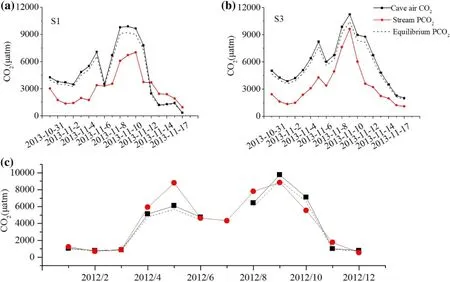
Fig.7 Daily(a,b)and monthly(c)cave air CO2,stream PCO2,and calculated equilibrium PCO2in stream water
5.3 Implications for speleothem paleoclimate studies
Speleothem δ13C has been used to reconstruct paleoclimate(Li et al.2011;Finne et al.2014),and variations in δ13C in stalagmites have been used to reflect changes in local vegetation(Meyer et al.2014).Monitoring δ13C of drip water and calcite on artificial substrates underneath drip sites is becoming more important when studying therecording mechanism of calcite δ13C(Luo et al.2014;Prasanna et al.2014).Previous studies have shown that δ13CDICof drip water is affected by many factors,such as isotopic composition of soil CO2,bedrock weathering,and in-cave processes(Oster et al.2012;Meyer et al.2014). Isotope fractionation occurs during limestone dissolution,calcite deposition,and CO2exchange between drip water and cave atmosphere(Spo¨tl et al.2005;Dreybrodt and Scholz 2011;Lambert and Aharon 2011).Isotope equilibriumfractionation,whichistemperature-dependent,between drip water and calcite is approximately 1±0.2‰(Mook et al.1974;Romanek et al.1992),but the kinetic fractionation associated with CO2degassing when drip water drops from the cave ceiling could cause deviations in calcite carbon isotope composition(Meyer et al.2014).
Variation of δ13CDICin drip water could be reflected by calcite δ13C,as discussed in previous studies(Dreybrodt and Scholz 2011).However,the variation of drip water δ13CDICmight be faster than calcite precipitating rate;daily changes in drip water δ13CDICmight not be reflected in calcite δ13C.Therefore,it remains unclear whether daily variations of cave air CO2could be recorded in calcite,as daily precipitation of calcite during our continuous monitoring was not observed.
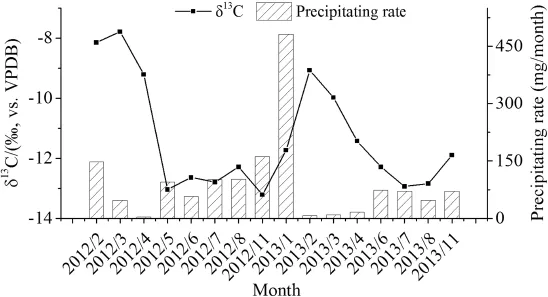
Fig.8 Monthly sediment precipitating rate and calcite δ13C under dripping site Sdw(some data absent)
Monthly δ13C data of sediment during our study are presented in Fig.8.δ13C showed seasonal fluctuations in sediment:high in winter and low in summer.Variations of δ13C in sediment were opposite to variations of monthly temperature,soil CO2,and cave air CO2.High cave air CO2concentrations in summer can inhibit degassing of drip water,with light carbon(12C)being incorporated into calcite and making calcite δ13C more negative(Dreybrodt and Scholz 2011).When cave air CO2concentration decreased in winter,degassing of drip water was rapid and calcite δ13C became more positive.Similar to the seasonal variation in degassing of drip water,sediment precipitation was rapid in winter and slow in summer.The highest rate of precipitation of sediment appeared in January 2013 in our study(Fig.8). The precipitation rate was not only controlled by cave air CO2but also by rainfall.In summer,more rainfall and higher soil CO2can result in higher concentrations of Ca2+in drip water(Pu et al.2015),but high air CO2concentrations in the cave inhibited CaCO3deposition.Low cave air CO2concentration favored CaCO3deposition in winter(Spo¨tlet al.Spo¨tl et al.2005),but less Ca2+was carried by reduced drip water(even no drip water in winter months during our study).Accordingly,the precipitation rate in January 2013 might be due to more drip water with a higher Ca2+concentration when cave air CO2was low,but the situation was different in different years due to the variations of rainfall and cave air CO2.Affected by different monthly precipitation rates,stalagmites under the drip water might consist primarily of sediment precipitated in months when the precipitation rate was high.
In summary,monthly sediment δ13C in Xueyu Cave(Fig.8)reflected seasonal variation of soil CO2and cave air CO2.Variation of calcite δ13C in our study was consistent with previous studies(Meyer et al.2014),indicating calcite δ13C in Xueyu Cave could be used to reflect environmental change outside the cave.However,considering different precipitation rates of sediment from drip water in different seasons,it was difficult to use stalagmites to reconstruct past seasonal changes.
6 Conclusion
Seasonal variations of air CO2in Xueyu Cave were notable:cave air CO2increased in April and decreased in November.Cave air CO2variation was consistent withvariations of atmosphere temperature and soil CO2.Affected by outside temperature and rainfall,hydrochemistry of the underground stream showed seasonal variation.Daily variations of cave air CO2,stream and drip water hydrochemistry were also notable in Nov 2013.The high cave air CO2with low pH,low SIc,low δ13CDIC,high Ca2+,and high PCO2of stream water occurring at almost the same time on Nov 9th revealed that air CO2was a dominant controlling factor on a daily scale of the stream hydrochemistry when there was no rainfall.On a seasonal scale,CO2carried by the underground stream in summer might accelerate the increase in air CO2in Xueyu Cave;higher CO2concentration inhibited outgassing of drip water and made calcite δ13C more negative.Seasonal variation of δ13C in sediment was inconsistent with atmosphere temperature,soil CO2,and cave air CO2,indicating calcite δ13C in Xueyu Cave could reflect seasonal changes of the external environment.Considering the different precipitation rate of sediment across seasons,it was difficult to use stalagmites to reconstruct past environment change on seasonal scale.
AcknowledgmentsThis work was supported by the National Natural Science Foundation of China(NO.41072192);Academician Foundation of Chongqing Science&Technology Commission(CSTC,2010BC7004;CSTC,2013JCYIYS20001).The authors thank the support of Daoxian Yuan,Yongjun Jiang and Junbing Pu for useful discussions.
Casteel RC,Banner JL(2015)Temperature-driven seasonal calcite growth and drip water trace element variations in a wellventilated Texas Cave:implications for speleothem paleoclimate studies.Chem Geol 392:43-58
DreybrodtW,ScholzD(2011)Climaticdependenceofstablecarbonand oxygen isotope signals recorded in speleothems:from soil water to speleothem calcite.Geochim Cosmochim Acta 75:734-752
Fairchild IJ,Smith CL,Baker A,Fuller L,Spotl C,Mattey D,McDermott F(2006)Modification and preservation of environmental signals in speleothems.Earth-Science Rev 75:105-153
Finne M,Bar-Matthews M,Holmgren K,Sundqvist HS,Liakopoulos I,Zhang Q(2014)Speleothem evidence for late Holocene climate variability and floods in southern greece.Quat Res 81:213-227
Hansen M,Dreybrodt W,Scholz D(2013)Chemical evolution of dissolved inorganic carbon species flowing in thin water films and its implications for(rapid)degassing of CO2during speleothem growth.Geochim Cosmochim Acta 107:242-251
LambertWJ,AharonP(2011)Controlsondissolvedinorganiccarbonand δ13C in cave waters from Desoto caverns:implications for speleothemδ13Cassessments.GeochimCosmochimActa 75:753-768
LiT,ShenC,LiH,LiJ,ChiangH,SongS,YuanD,LinCD,GaoP,Zhou L(2011)Oxygen and carbon isotopic systematics of aragonite speleothemsandwaterinFurongCave,Chongqing,china.Geochim Cosmochim Acta 75:4140-4156
Linan C,Vadillo I,Carrasco F(2008)Carbon dioxide concentration in air within the NerjaCave(Malaga,Andalusia,Spain).Int J Speleol 37:99-106
Liu ZH,Li Q,Sun HL,Wang JL(2007)Seasonal,diurnal and stormscale hydrochemical variations of typical epikarst springs in subtropical karst areas of SW China:soil CO2and dilution effects.J Hydrol 337:207-223
Lobo H,Boggiani PC,Perinotto J(2015)Speleoclimate dynamics in Santana Cave(Petar,s(a)over-tildeopaulo state,Brazil):general characterization and implications for tourist management.Int J Speleol 44:61-73
Luo WJ,Wang SJ,Zeng GN,Zhu XL,Liu W(2014)Daily response of drip water isotopes to precipitation in Liangfeng Cave,Guizhou province,SW China.Quat Int 349:153-158
Meyer KW,Feng WM,Breecker DO,Banner JL,Guilfoyle A(2014)Interpretation of speleothem calcite delta C-13 variations:evidence from monitoring soil CO2,drip water,and modern speleothem calcite in central Texas.Geochim Cosmochim Acta 142:281-298
Mook WG,Bonmmerso JC,Staverman WH(1974)Carbon isotope fractionation between dissolved bicarbonate and gaseous carbon dioxide.Earth Planet Sci Lett 22:169-176
Oster JL,Montanez IP,Kelley NP(2012)Response of a modern cave system to large seasonal precipitation variability.Geochim Cosmochim Acta 91:92-108
Prasanna MV,Nagarajan R,Chidambaram S,Manikandan S,Elayaraja A(2014)Drip water geochemistry of NiahGreat Cave,NWBorneo,Malaysia:a base line study.Carbonates Evaporites 29:41-54
Pu JB,Yuan DX,Zhao HP,Shen LC(2014)Hydrochemical and PCO2variations of a cave stream in a subtropical karst area,Chongqing,SW China:piston effects,dilution effects,soil CO2and buffer effects.Environ Earth Sci 71:4039-4049
Pu J,Wang A,Yin J,Shen L,Sun Y,Yuan D,Zhao H(2015)Processes controlling dripwater hydrochemistry variations in Xueyu Cave,SW China:implications for speleothem palaeoclimate signal interpretations.Boreas.doi:10.1111/bor.12117
Romanek CS,Grossman EL,Morse JW (1992)Carbon isotopic fractionationinsyntheticaragoniteandcalcite-effectsof temperature and precipitation rate.Geochinica et cosmochimica Acta 56:419-430
Sanchez-Canete EP,Serrano-Ortiz P,Domingo F,Kowalski AS(2013)Cave ventilation is influenced by variations in the CO2-dependent virtual temperature.Int J Speleol 42:1-8
Sebela S,Turk J(2011)Local characteristics of Postojna Cave climate,air temperature,and pressure monitoring.Theor Appl Climatol 105:371-386
Sherwin CM,Baldini J(2011)Cave air and hydrological controls on prior calcite precipitation and stalagmite growth rates:implications for palaeoclimate reconstructions using speleothems. Geochim Cosmochim Acta 75:3915-3929
Spo¨tl C,Fairchild IJ,Tooth AF(2005)Cave air control on dripwater geochemistry,Obir Caves(Austria):implications for speleothem deposition in dynamically ventilated caves.Geochim Cosmochim Acta 69:2451-2468
Taipale SJ,Sonninen E(2009)The influence of preservation method and time on the delta C-13 value of dissolved inorganic carbon in water samples.Rapid Commun Mass Spectrom 23:2507-2510
Troester JW,White WB(1984)Seasonal fluctuations in the carbon dioxide partial pressure in a cave atmosphere.Water Resour Res 20:153-156
Wang A(2010)Study on operation regularity and environmental information reservation of cave karst dynamic system.Dissertation,Southwest University
Wang X,Wang F,Xu S(2013)Hydrogeochemical variations of groundwater during a rainstorm in Xueyu Cave,Chongqing and the estimation of its carbon sink.J Southwest Univ(Nat Sci Ed)35:97-103
Wei X,Liu W(2014)Current research hotspots of international karst speleology:interviewwithacademicianYuanDaoxian. J Chongqing Normal Univ(Nat Sci Ed)31:1-5
Wigley TML(1977)WATSPEC:a computer program for determining the equilibrium speciation of aqueous solutions.Geo Abstracts for the British Geomorphological Research Group
Yuan DX,Cheng H,Edwards RL,Dykoski CA,Kelly MJ,Zhang ML,Qing JM,Lin YS,Wang YJ,Wu JY,Dorale JA,An ZS,Cai YJ(2004)Timing,duration,andtransitionsofthelast Interglacial Asian Monsoon.Science 304:575-578
Zhang C,Yuan DX,Cao JH(2005)Analysis on the environmental sensitivities of typical dynamic epikarst system at the Nongla monitoring site.Environ Geol 47:615-619
Zhang W,Wu J,Wang Y,Wang Y,Cheng H,Kong X,Duan F(2014)A detailed east Asian Monsoon history surrounding the‘mystery interval’derived from three Chinese speleothem records.Quat Res 82:154-163
10 September 2015/Revised:14 October 2015/Accepted:1 December 2015/Published online:18 December 2015ⒸScience Press,Institute of Geochemistry,CAS and Springer-Verlag Berlin Heidelberg 2015
猜你喜欢
杂志排行
Acta Geochimica的其它文章
- Transmission electron microscopic study of the fine-grained vein matrix in the Suizhou L6 meteorite
- An optimized sequential extraction scheme for molybdenum association in environmental samples
- Nutrient uptake by mulberry and Chinese prickly ash associated with arbuscular mycorrhizal fungi
- Quantification of photosynthetic inorganic carbon utilisation via a bidirectional stable carbon isotope tracer
- Tin partition behavior and implications for the Furong tin ore formation associated with peralkaline intrusive granite in Hunan Province,China
- Improvement of saponification extraction method for fatty acids separation from geological samples
